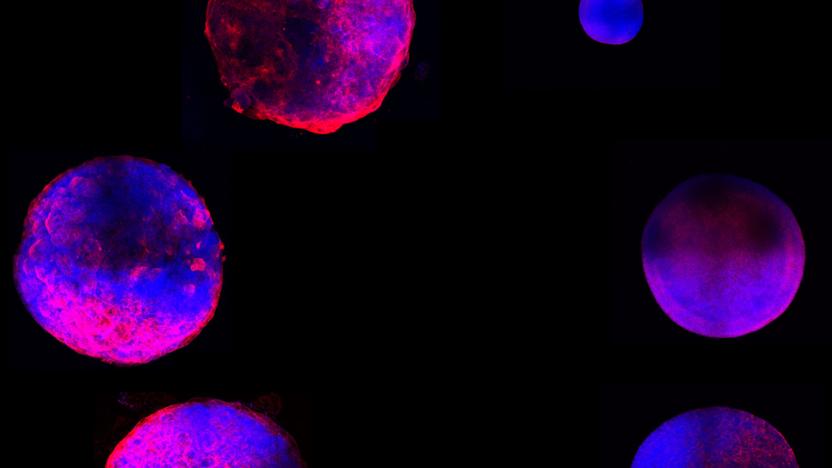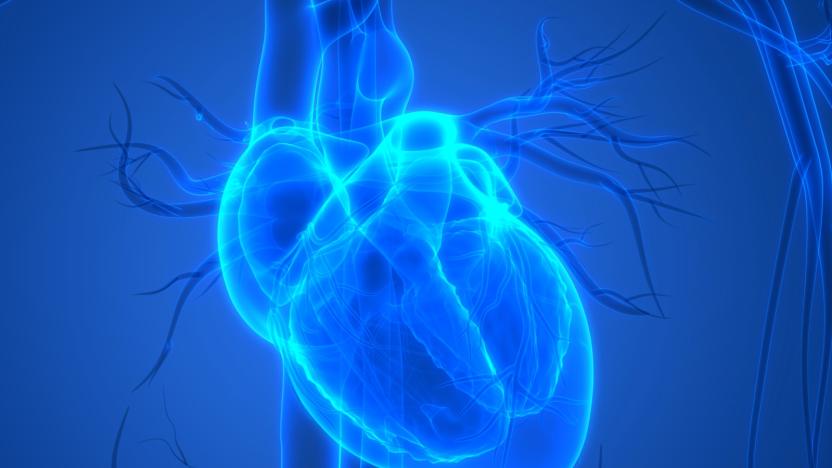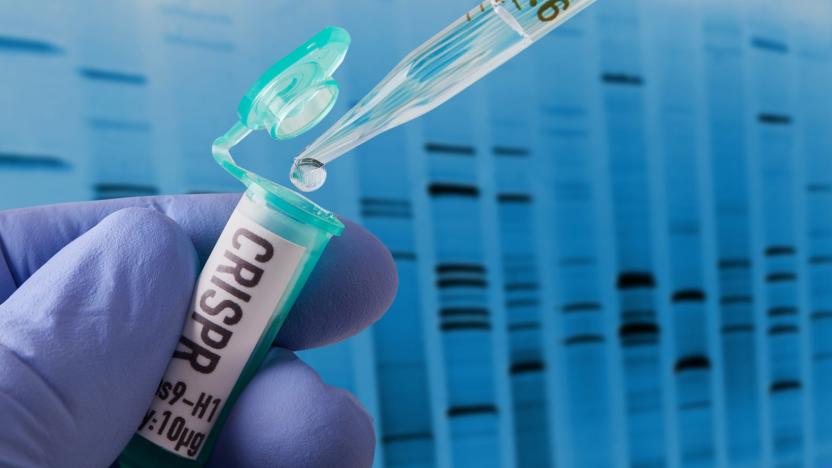stem cells
Latest

Researchers grew a mini human heart to study fetal heart development
A team of scientists have grown a miniature human heart to better understand fetal heart development.

Scientists created living robots out of stem cells
Scientists have created a new life form that's something between a frog and a robot. Using stem cells scraped from frog embryos, researchers from the University of Vermont (UVM) and Tufts University assembled "xenobots." The millimeter-wide blobs act like living, self-healing robots. They can walk, swim and work cooperatively. Refined, they could be used inside the human body to reprogram tumors, deliver drugs or scrape plaque out of arteries.

Spay and neuter your pets -- and then bank their stem cells
Being man's best friend has a number of perks, one of which is that dogs get access to all the latest medical science, including, as it turns out, stem cell therapy. A company called Gallant is launching a new bank for canines nationwide (not called Barklays, alas) that allows you to cryopreserve your dog's stem cells for future use.

Chicago biotech company 3D prints a mini human heart
The Chicago-based biotech company BIOLIFE4D announced today that it has successfully 3D-bioprinted a mini human heart. The tiny heart has the same structure as a full-sized heart, and the company says it's an important milestone in the push to create an artificial heart viable for transplant.

Stem cell transplant offers hope for an HIV cure
There appears to be more than one promising sign in the quest for an HIV cure. Researchers have given a London patient a bone marrow stem cell transplant that has left him HIV-free for the past 18 months. As the donor has a very rare genetic mutation (CCR5 delta 32) that makes them HIV-resistant, the stem cells sent the HIV into remission with only a "mild reaction" from the treatment. It's a positive sign, and it suggests that the stem cell transplants that 'cured' Tim Brown in 2007 weren't just flukes.

Scientists use CRISPR to make stem cells invisible to immune system
Scientists at the University of California San Francisco have developed a new method to minimize the likelihood that a person's body will reject stem cells during a transplant. Using the CRISPR gene editing tools, the scientists managed to create stem cells that are effectively invisible to the body's immune system.

Scientists take a step towards curing infertility with stem cells
Stem cells are basically like biological alchemy. You can turn them in to almost anything, including it seems sperm or eggs. Researchers working jointly in the UK and Israel have figured out how to create precursor cells for gametes, you know the bits that combine during fertilization to create a tiny human. There's still a long way to go before viable eggs or sperm can be created in a petri dish, but this is a major first step. The hope here is that one day couples where either partner (or both) suffer from infertility could have a child. The process would obviously still be involved and difficult for the couple, much like in vitro.

Engadget Daily: Tesla's Model 3, new buyer's guides and more!
Elon Musk reveals Tesla's latest electric vehicle, we show off our new buyer's guides, discover we still have a lot to learn about stem cells and take a trip to Taiwan with T-Mobile's new global roaming plan. Read on for Engadget's news highlights from the last 24 hours.

Experimental stem cell treatment causes woman to grow parts of a nose on her spine
Stem cells are seen as one of modern medicine's most promising magic bullets, but that doesn't mean that we understand them. A paralyzed woman from the US has learned this the hard way, after an experimental treatment caused her to grow a nose-like tumor on her back. The unnamed person took part in a trial whereby stem cells from her nose were applied to her spine in the hope that it could repair the nerve damage that led to her paralysis. Unfortunately, the treatment was unsuccessful and, eight years later, the subject found worsening pain in that same area. When surgeons operated, they found a tumor comprised of nasal tissue that was producing a thick substance that was remarkably close to mucus.

Scientists 3D-print embryonic stem cells, pave the way for lab-made organ transplants
3D printers already have a firm footing the commercial market, with more than 20 models available for well-heeled DIYers, and the technology's appeal isn't lost on the scientific community. A team at Heriot-Watt University in Edinburgh, Scotland has developed a method for 3D-printing clusters of human embryonic stem cells in a variety of sizes. Researchers have successfully printed 3D cells before, but this is the first time that embryonic cell cultures, which are especially delicate, have been built in three dimensions. Human embryonic stem cells can replicate almost any type of tissue in the human body -- and the scientists at Heriot-Watt believe that lab-made versions could one day be used to make organ transplants, thereby rendering donors unnecessary. In the nearer future, 3D-printed stem cells could be used to make human tissue models for drug testing; effectively eliminating the need for animal testing. Makes that Burritob0t look a little less ambitious, doesn't it?

Regenerative medicine pioneer continues changing lives with first successful laryngotracheal implants
Dr. Paolo Macchiarini is no stranger to world firsts, and less than a year after performing a synthetic windpipe transplant, the Karolinska Institute Professor has coordinated no less than two successful transplants of synthetic sections of larynx. Amazingly, both patients were able to breathe and talk normally straight after surgery, the basic functions we take for granted that they either struggled with or were simply unable to do before. The implants consisted of personally designed synthetic scaffolds coated with the candidates' own stem cells, so there's neither the chance of rejection nor the burden of life-long immunosuppressant therapy. Despite the amazing feat, Dr. Macchiarini ain't done yet, claiming this is the first of many steps towards building a synthetic, complete larynx -- voice box and all. Jump past the break for the official PR issued by Harvard Bioscience, the company responsible for growing what's in that tub.

Over the counter, spray-on stem cell treatment could heal burns on the go
Research at the University of Utah could lead to burn treatment on the go that makes use of your body's own cells. Surgeons Amit Patel and Amalia Cochran are researching the use of stem cells in conjunction with several chemicals as a spray-on jelly which has, in early testing, shown to accelerate the healing process of burns. While the team is starting with small burns, its goal is to be able to provide fast and effective, actual regeneration of a patient's own cells to be grafted onto large area burns. Video of the project is after the break.

Stem cell therapy restores British man's eyesight
Russell Turnbull, now 38, lost almost all the sight in his right eye after trying to break up a fight and being sprayed with ammonia 15 years ago. The result for him was what's known as Limbal Stem Cell Deficiency, which caused him great pain, the need for therapeutic treatment, and economic dependency. Good news for Russell is that he can put all that behind him now, after becoming one of the first recipients of a new stem cell grafting procedure, whereby healthy tissue from his left eye was implanted into his right and -- just like a video game medpack -- restored his vision to normal. For the moment, this treatment is limited to patients with at least one healthy eye, but given the pluripotent nature of stem cells, it is hoped that tissue from elsewhere in the body could one day be used to regenerate damaged parts, such as the cornea in this case. You may find further enlightenment in the video after the break.

DARPA teams up with Arteriocyte to create ominous-sounding blood pharming machine for the military
DARPA's been running a blood pharming program for quite awhile now, but it's gotten a real kick start this week with the announcement of a partnership with Cleveland-based biotech company Arteriocyte. Arteriocyte, it seems, has developed a Nanofiber Based System, or NANEX, a technology that enables the production of red blood cells without a donor. The two companies hope research will eventually lead to an "in theatre" blood-making machine for the military. So, if there's no donor, where do the progenitor cells come from? Well, that's a little hazy at this point, though Arteriocyte developed the NANEX using "blood of the umbilical cord" (stem cells), but we don't know what will fuel the final product. Personally, we hope they can squeak out a way to do it using the less controversial "blood of the dragon."[Via CNet]

Scientists unveil bio-inkjet printer for stem cells, creating bone-type cells
A bioengineering team from Carnegie Mellon University and the Pittsburgh School of Medicine have presented a way to employ techniques based on inkjet printers to help stem cells become bone tissue cells. The team uses a set of inkjet-style streams to shoot little bits of proteins (like droplets of printer ink) on top of nurturing proteins (think of them as the paper) in a certain pattern. Then the team drops stems cells on top of the whole concoction, which depending on what bio-ink was used, can turn into bone-type cells or potentially even other cell types. While human trials are still a ways off, let's just hope that bio-ink cartridges aren't nearly as much of a scam as regular inkjet cartridges are when they reach that point. [Via NewScientist]








